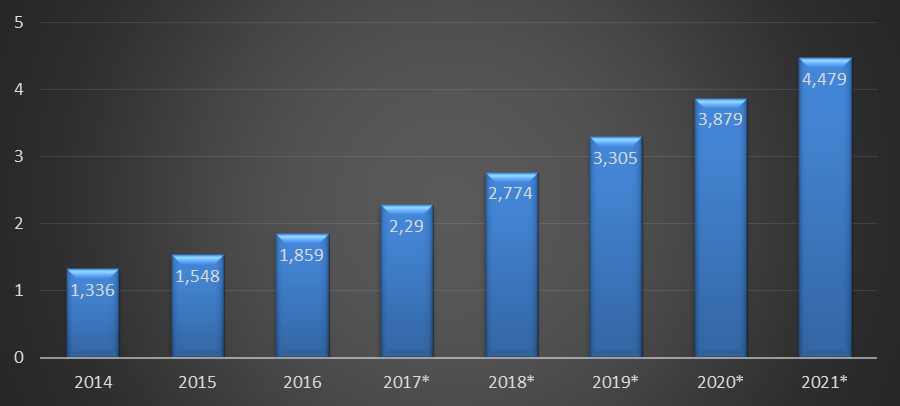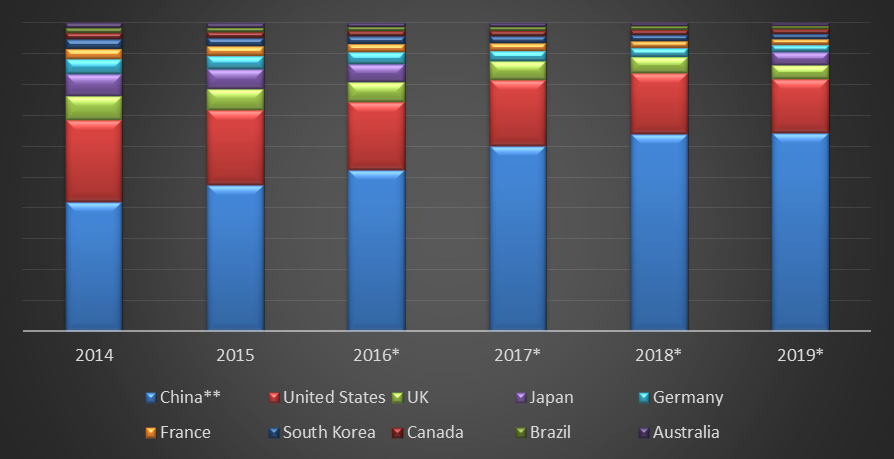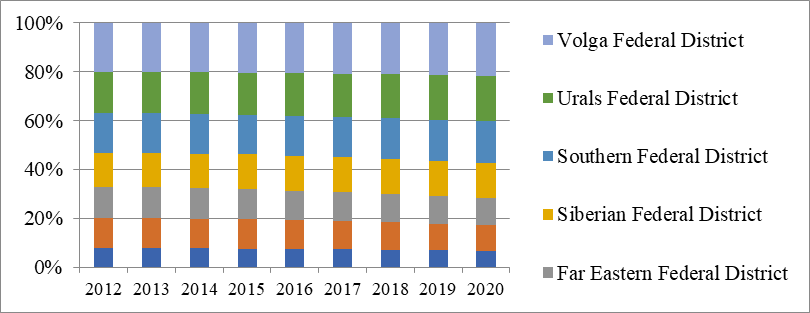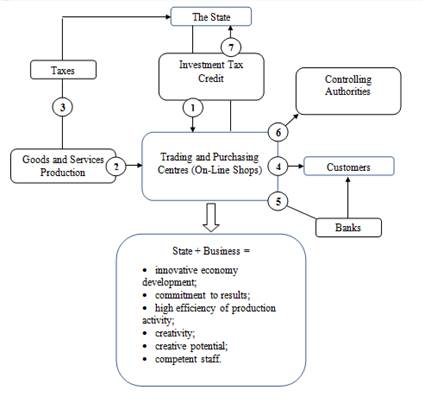Abstract
The article touches upon the issues of the development of one of the most fast-evolving for now fields of activity – the electronic commerce field. The electronic commerce market will grow with the same rate during the next decade, and its growth directions will extend to the majority of manufacturing enterprises. The range of development problems in the RF modern electronic trade market is determined and the usage of the collected statistical data allows projecting the tendencies of the goods and services sale on the Internet until 2020. As the electronic commerce market development is directly linked with the innovative component of the Russian economy development, the model of the interactions between the parts of the e-commerce sphere that is up for the modern development trends was offered. Besides, the investing innovative instruments were defined as the basic group of instruments helping to boost the given sphere. With the aid of these instruments the state will allow the Russian manufacture to raise the production and sale of the innovative goods (services) using the most promising technologies of the e-commerce sphere that will have a positive impact on the economy of the country as a whole.
Keywords: Electronic commerceinvestmentsbusiness-processescompetitioninnovative economyinvestment tax credit
Introduction
Under the modern conditions of the national economy development, the tasks of developing the innovative component of the activity of any business are of high importance as it is one of the basic components aimed at increasing the business productivity. Traditional methods of doing business in Russia do not fully conform to the trends of the international business development. One of the modern approaches to the business conducting is electronic commerce.
Electronic commerce is used as a fast means of transforming the world into the information-oriented society. Electronic commerce expands the business conception from the simple transactional approach to the wider and more complicated conception of the intercompany collaboration. At times of the market globalization, growing interdependence of the national economies the usage of electronic commerce remains a significant phenomenon, though a very complicated and elusive one, there is not much knowledge about its determinants (Awagah, Kang, & Lim, 2015). In the sphere of business, electronic commerce made significant progress both in large organizations and in small and medium-sized businesses.
With the appearance of the Internet-technologies, electronic commerce became very important during the last several years. The fast development of the information technologies and the Internet network created the absolutely new conditions for developing business (Al-Khouri, 2014; Al‐Hawamdeh, 2002.).
Though the level of electronic commerce implementation constitutes a small part of the economy in many countries, many specialists speak about the usage of electronic commerce as a possible means of reducing the costs and increasing the productivity (Chan & Al‐Hawamdeh, 2002; Goldmanis, Hortaçsu, Syverson, & Emre, 2010; Kartiwi & MacGregor, 2007).
The given research is quite topical nowadays because the conventional structure of the activity of many businesses is changing and developing due to the creation and improvement of the new information technologies, namely it is shifting towards the electronic commerce development.
Problem Statement
The estimates of the growth of the world electronic commerce market (according to the data of statista.com) shows that in the future one can expect the constant growth of the number of goods and services sold by means of electronic commerce not only in the household industry but also in the manufacturing ones. Thus, to support the competitiveness of the Russian economy and development of its structure in compliance with the development trends of more advanced countries, the rate of the domestic electronic commerce market growth should be up to the global rate. Nowadays the electronic commerce market changed the understanding of the business conducting methods existed during last 20-30 years for the entire world.
The rates of growth and the volume of on-line sales in Russia are behind the worldwide ones. In this sphere, a set of issues and problems demanding the urgent solution can be determined. The analysis of the development tendencies and revelation of the dominant structural elements in the electronic commerce sphere are the necessary conditions for the future development of the given field and of the country’s economy as well.
Research Questions
While studying the issues linked with the electronic commerce market development, one can determine the most significant ones – the prospective volumes of the entire market growth as well as of its parts, the current world and Russian practice of doing business in this field, finding out the factors that influence the studied sphere. On the grounds of the data discovered during this study it is possible to create a model of interaction between the main parts of the electronic commerce market that corresponds to the modern stage of development, and to work out the measures able to boost the market growth in compliance with the global trends.
Purpose of the Study
The purpose of the scientific article is to appraise the significance of electronic commerce for the national economy growth, as well as to find out the tendencies and trends facilitating this field development and grounding on the investing innovative approaches. The data obtained will allow confirming the significance of the e-commerce sphere in the ongoing structural changes of the RF economic system and creating the productive model of electronic commerce in Russia that conforms to the modern structure of the world economy.
Research Methods
In the context of this study, it is necessary to analyze the different conceptions of the leading economists presenting the definition of electronic commerce. In the opinion of Matt Haig, electronic commerce is any form of business conducting by means of the Internet (Haig, 2001).Daniel Amor defines electronic commerce as a type of business operations, financial transactions, causing the usage of the leading information technologies and communication environments in order to ensure higher economic efficiency in comparison with the traditional types of business (Amor, 2001).
One of the Russian scientists, Pirogov, considers “electronic commerce” as a technology of making commercial deals and managing production processes with the usage of the electronic tools of data exchange.
In general, the category of “electronic commerce” refers to the economic activity field where all the financial and electronic transactions are made by means of modern information technologies. The notion of “electronic commerce” is closely related to the notion of “electronic business” and can be regarded as its component. Electronic business as an economic category involves a business activity via the global information and telecommunication networks in order to gain profit. The main difference between electronic commerce and electronic business lies in the fact that electronic commerce is a form of making deals, whereas electronic business is the main direction of the business activity of an enterprise aimed at transforming the business-processes of this enterprise activity.
Electronic commerce imposes the significant changes of the “traditional” forms of business. The information and Internet technologies create a new interior culture of business, the ability of fast adjustment of the business model and strategy to the changing conditions of the economic activity and new possibilities. They are the key factors of the enterprise success in the rapidly changing conditions of the Internet-economy (Cambra-Fierro, Iguácel & Javier, 2017; Ching-Chieh & Chien-Sing, 2017; Gajendra &Wang, 2016; Alderete, 2017).
Analysis of the foreign and domestic experience of electronic commerce market
The most developed and rapidly growing market in the field of electronic business is consumer goods sales. Originally, the growth of this very segment of electronic commerce market was really intensive and played a part of the driving force for electronic commerce development in other industries in foreign countries and in Russia as well. The available historical data give the possibility to size up the prospects and expected growth rates of the consumer goods market and also to lay the groundwork for the growth in other industries(Cambra-Fierro, Iguácel & Javier, 2017; Gajendra & Wang, 2016; Alderete, 2017).
Statistics data show that the volume of all the retail electronic commerce sales in the world amounted to 7.4% in 2015. In 2017-2018 the slowdown in the growth of electronic commerce development is seen – the specialists think it is caused by the global economic crisis; however, according to projections, the growth will double in 2021 and it will be 15.5%.Let us consider the dynamics of the retail electronic commerce sales worldwide in 2014-2021 in absolute terms (Figure

In 2014 the volume of retail electronic commerce sales in the world was 1.336 trillion of US dollars and nowadays it already amounts to 2.29 trillion of US dollars and it is planned that in 2021 the incomes in electronic retail trade will grow to 4,48 trillion of USD. The most popular gadgets that are bought on-line are personal computers, tablets, cellphones and other electronic devices. In the USA in January 2017, the consumer goods were the electronic commerce category growing in the fastest rate. Figure

China heads the list of the retail electronic commerce sales: in 2014 the sales volume was valued as 472.91 billion USD, whereas it is projected that the volume will grow to 1973.04 billion USD by 2019, which is 23.96% more than the indices of the previous years. In the authors’ opinion, China took first place in the sales because of the large population and advanced export network in the world. The United States were ranked second: in 2014 the sales amounted to 298.26 billion USD, and in 2019 the sales are projected to grow to 534.94 billion USD which is 55.75% more.
There are the following countries in the list of 10 top leading ones: Ukraine, Japan, South Korea, Canada, Brazil. Australia is the last in the list: in 2014 its index was 17.4 billion USD and in 2019 it may amount to 25.61 billion USD which is 8.21 billion USD more. Despite all the advantages of the already existing giants of the e-commerce market, the online markets are also developing in the other countries: Malaysia, India, Russia. Though Russia was not put in the list of 10 top leading e-commerce countries, it has real prospects for the future growth. The electronic commerce market in Russia began to develop not long ago. In 2009-2013, the growth rates were increasing very slowly – approximately 1-2% per year.
During the last several years, the growth of the Russian electronic commerce market can be seen: in 2013 the sales volume was valued as 500 billion roubles, in 2017 it is about 1450 blnroubles and in 2020 it is to grow to 2180 billion roubles. That is illustrative of the constant growth rates at the level of 15-20% annually. In 2016 about 22-23 million of the Russians made purchases on the Internet. The electronic commerce market is the one of the most rapidly growing markets in Russia that leads to the constant increase of the quantity of on-line buyers. The projection of the on-line sales distribution throughout the regions of Russia is presented in Figure

The above-mentioned data show that in the towns with the population more than 100000 people the index of electronic technologies penetration is more than 30-40%. These numbers are indicative of the high degree of the possible structural transformation in many goods and services markets and of the significant predominance of the electronic deals within the next few years.
The biggest part in the structure of the Russian on-line trade market is presented by the sales of air tickets, clothes, shoes accessories and digital equipment, that is, consumer goods. Besides, there are such segments as household appliances, digital content, communication services, railroad tickets, fees and sanctions payments. All in all, these segments of the Russian on-line trade market constitute about 60% of the whole market volume. In addition, the cross-border trade constitutes a significant share of the digital equipment and electronics market, as well as of clothes, shoes and accessories markets. The other segments such as cosmetics, perfume, children goods, car goods, furniture constitute 40% in the structure of the Russian on-line trade market. Now one can note the increase of the sales volumes on the Internet in such spheres as selling construction materials, specialized equipment, medicines etc. (both for retail and whole sale customers).
The sphere of consumer goods sales is an indicator for the growth of other manufacturing industries. It is also very important that the development of the remote trading channels changes the structure of costs caused by production and sales of any product.
Another distinctive feature of the Internet trade is conditioned by the territorial peculiarities of a country. There would be a great advantage of the domestic on-line shops – short terms of delivery; but taking into account the large distances between the big towns where the trading warehouses are located, the possible ways of delivery, their prices one cannot regard it as an advantage. The price of the delivery within the country equals or even exceeds the price of the delivery from abroad, and the terms do not differ greatly.
The development of the mobile apps and mobile Internet influences the development of the Russian electronic commerce market and it amounts to 70% for now. In the context of the increase of the number of smartphones and tablets, users one can project the increase of the total intrinsic base of the mobile Internet to 150 million subscribers by the end of 2018. Among the factors facilitating this process ,the rise of the reduction of the mobile Internet cost, implementation of the technologies of the high-speed data transmission and development of the additional mobile services used for making on-line purchases. In view of the analysis, the given Russian segment is not developed enough in comparison with the rapidly growing countries.
Among the basic reasons, retarding the development of electronic business in the Russian Federation, there is the high level of foreign competition, drawbacks in the legislative regulatory system and poor logistics links in the regions. To overcome these difficulties, the great volume of investments and the governing impact of the public authorities are necessary.
The state intervention is necessary for the development of the electronic commerce market in Russia. The governing role of the state is one of the components of electronic commerce institutionalization and one of the factors of forming the marketing environment of the global network economy. The public task in this sphere is to work out the legal regulations and rules of electronic commerce and to make it transparent by means of the accelerated creation of the network infrastructure. If electronic commerce infrastructure is not built in Russia during the next few years, the foreign trading networks will close out the market.
the model of interaction between the electronic commerce participants in the context of the innovative economy development in russia
Taking into account the conclusions made during the analysis of the current situation in the electronic commerce sphere it is possible to determine the basic parties and the order of their interaction necessary for implementation of measures boosting this sphere. On the basis of it, the general model was designed (Fig.

where:
Organizational economic relations between the state and the borrower.
Investing the investment tax credit in the innovative goods and services.
Return of duties to the budget.
Sale of innovative goods and services on the Internet.
Credits extension via the credit organizations (if necessary).
Audit by the controlling authorities.
Return of the funds in the form of payments of loan amount and interest charges.
The expediency and efficiency of the managerial decisions in this sphere are the key factors of successful modernization of the Russian Federation economy and creation of the integrated Eurasian economic space (Kartiwi & MacGregor, 2007)
In the author’s opinion, it is necessary to introduce new approaches and instruments of improving electronic commerce and business that will allow developing the prior directions of the economy.
Findings
Taking into account the results obtained during this study, it seems possible to determine the basic measures of boosting the electronic commerce market in Russia:
Making changes in some regulatory and legislative documents in order to improve the laws that will allow the customers not to be afraid of buying the goods with the help of mobile devices on the Internet and to be sure of non-disclosure of the personal data.
Training of skilled specialists in the sphere of electronic commerce and business.
Extension of the international cooperation at the on-line markets.
Participation in the international trading-industrial exhibitions.
Popularization of electronic commerce among enterprises and customers.
Introduction of the Russian goods into the foreign markets.
Improvement of the service system for the electronic commerce customers including the logistics market. It is necessary to develop the multi-channel strategies of retail at the logistics market allowing the customer to choose the most convenient models of order, delivery, payment and return.
Establishing the controlling and monitoring authorities in order to maintain the necessary level of economic safety.
Locating the warehouses for the on-line trade in the rapidly developing regions of the country that will help to attract more customers from the remote regions.
Development of electronic business for the enterprises of the basic industries.
One of the main problems of electronic commerce development is the replacement of the traditional trading mechanism. It should be mentioned that electronic commerce does not only mean the usage of IT-technologies in the traditional commerce; it is an innovative sphere of the commercial activity where the Internet is an environment of the commercial organization functioning. Nowadays electronic commerce is dynamically used in the everyday life and in the short term, this model of business organization will become even more widespread.
A lot of researches think that for the development of the innovative on-line markets the venture investments should be made. Public Private Partnership may become another instrument for the stimulation. The given methods and instruments will make it possible to develop electronic commerce in Russia very successfully. In the author’s opinion, one of the instruments boosting the electronic commerce market is the implementation of the investment tax credit for the innovation trends.
Conclusion
The promising and novel trend in the development of the Russian innovation organizations is electronic commerce. During the research ,the analysis of the domestic and foreign practices of electronic commerce was carried out and it shows that the development of electronic commerce in different countries is characterized by the positive dynamics of the market volume and the increased penetration of the Internet into all spheres of activity.
The given package of measures aimed at tax policy making will facilitate the sustainable development of the innovative activity at the market of the Internet trading. It is important to note that the importance of electronic commerce in Russia will dynamically grow and promote the development of the innovative economy, appearance of new profitable offers at the market, effective competition, and thus improved quality of goods and services, possibility to come into the global markets, reduced expenses for the deals transaction. All these factors cause the reduction of goods/services prices, an increase of demand etc.
References
- Alderete, & Veronica, M. (2017).The Age of Prosumerism: Some Micro-Economic Analysis. The Journal of Theoretical and Applied Electronic Commerce Research, 3(12). ISSN 0718-1876
- Al-Khouri, A.M. (2014). Digital identity: transforming GCC economies. Innov: Manage Policy Pract, 16(2), 184-194.
- Amor, D. (2001). The e-buisness (r)evolution. Publisher: Prentice Hall,2 edition. ISBN-10: 0130670391
- Awagah, R., Kang, J., & Lim, J. I. (2015). Factors Affecting E-Commerce Adoption among SMEs in Ghana. Information Development, 4 (32), 815-836.
- Chan, B., & Al‐Hawamdeh, S. (2002). The development of e‐commerce in Singapore: The impact of government initiatives. Business Process Management Journal, 3(8), 278-288. Retrieved from: https://doi.org/10.1108/14637150210428970
- Cambra-Fierro, Jesús., Melero, J.I., & Sese, F. (2017). Online customer-initiated contacts and the development of profitable relationships. Electronic Commerce Research and Applications,26, 13-22. Retrieved from: https://doi.org/10.1016/j.elerap.2017.09.004
- Ching-Chieh, Kiu. & Chien-Sing, Lee. (2017).E-commerce market trends: a case study in leveraging Web 2.0 technologies to gain and improve competitive advantage. International Journal of Business Information Systems (IJBIS), 3(25), 3.Retrieved from: https://doi.org/10.1504/IJBIS.2017.084451
- Electronic Materials. E-commerce statistics. European statistics explained. Retrieved from:http://ec.europa.eu/eurostat/statistics-explained/index.php/E-commerce_statistics (24.12.2017)
- Electronic Materials. E-commerce statistics. Retrieved from:http://statista.com. (17.09.2017)
- Gajendra, S. & Wang, L. (2016). The effects of online service quality of e-commerce Websites on user satisfaction. The Electronic Library, 3(33), 468-485. Retrieved from: https://doi.org/10.1108/EL-10-2013-0193
- Goldmanis, M., Hortaçsu, A., Syverson, C., & Emre, O. (2010). E-commerce and the market structure of retail industries. The Economic Journal,120(545), 651-682.
- Haig, M. (2001). E-Business Essentials.Publisher: Kogan Page Ltd ISBN: 0749435275
- Kartiwi, M., & MacGregor, R. (2007). Electronic commerce adoption barriers in small to medium-sized enterprises (SMEs) in developed and developing countries: A cross country comparison. Journal of Electronic Commerce in Organization, 5(3), 35-51.
- Al‐Hawamdeh, S. (2002). The development of e‐commerce in Singapore: The impact of government initiatives. Business Process Management Journal, 3(8), 278-288. Retrieved from:https://doi.org/10.1108/14637150210428970
Copyright information

This work is licensed under a Creative Commons Attribution-NonCommercial-NoDerivatives 4.0 International License.
About this article
Publication Date
17 December 2018
Article Doi
eBook ISBN
978-1-80296-049-5
Publisher
Future Academy
Volume
50
Print ISBN (optional)
-
Edition Number
1st Edition
Pages
1-1464
Subjects
Social sciences, modern society,innovation, social science and technology, organizational behaviour, organizational theory
Cite this article as:
Gorbachevskaya, E. Y., Arkhipkin, O., & Shilnikova, I. (2018). Significance Of Electronic Commerce In Development Of Rf Innovative Economy. In I. B. Ardashkin, B. Vladimir Iosifovich, & N. V. Martyushev (Eds.), Research Paradigms Transformation in Social Sciences, vol 50. European Proceedings of Social and Behavioural Sciences (pp. 449-458). Future Academy. https://doi.org/10.15405/epsbs.2018.12.54

